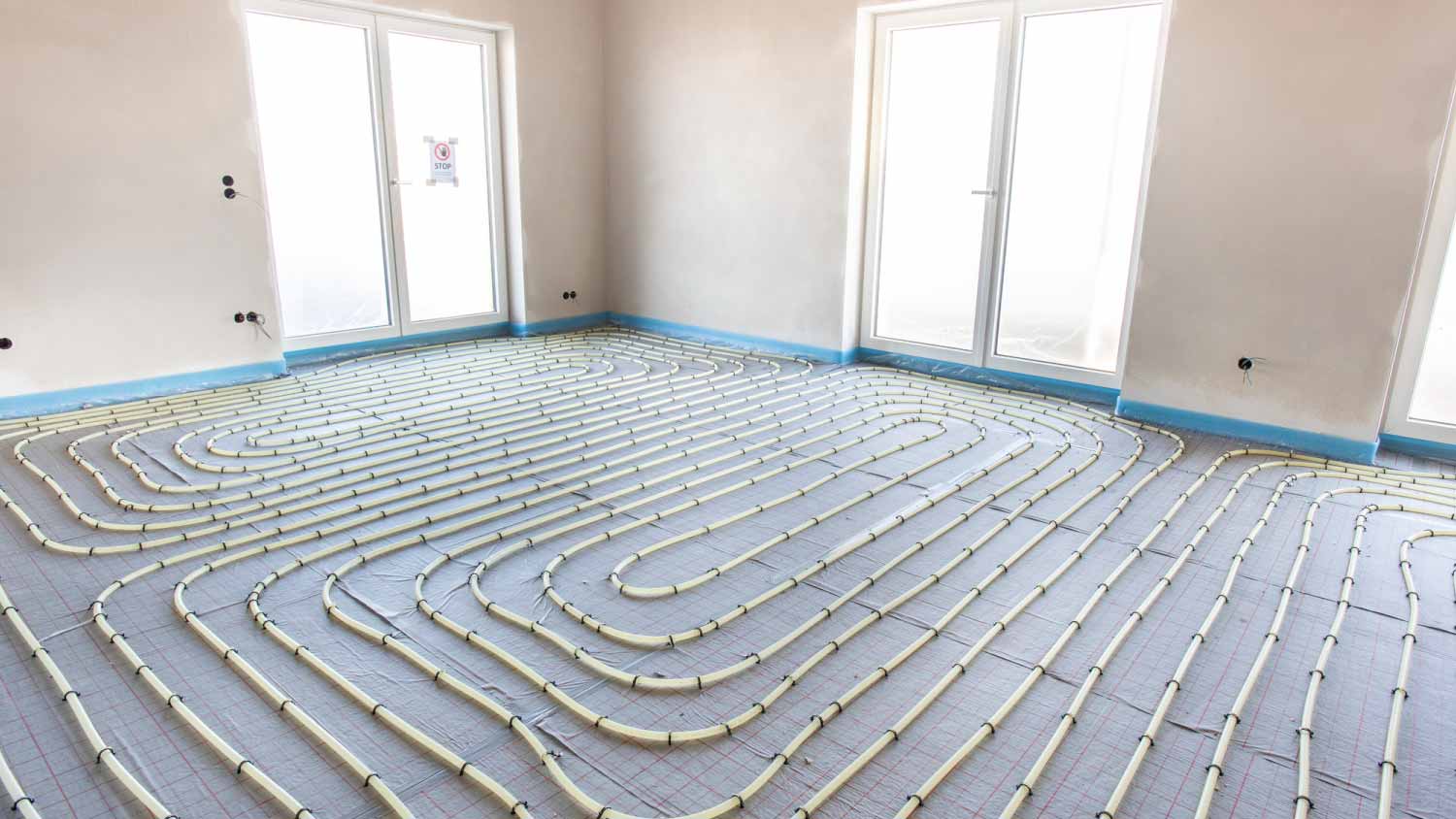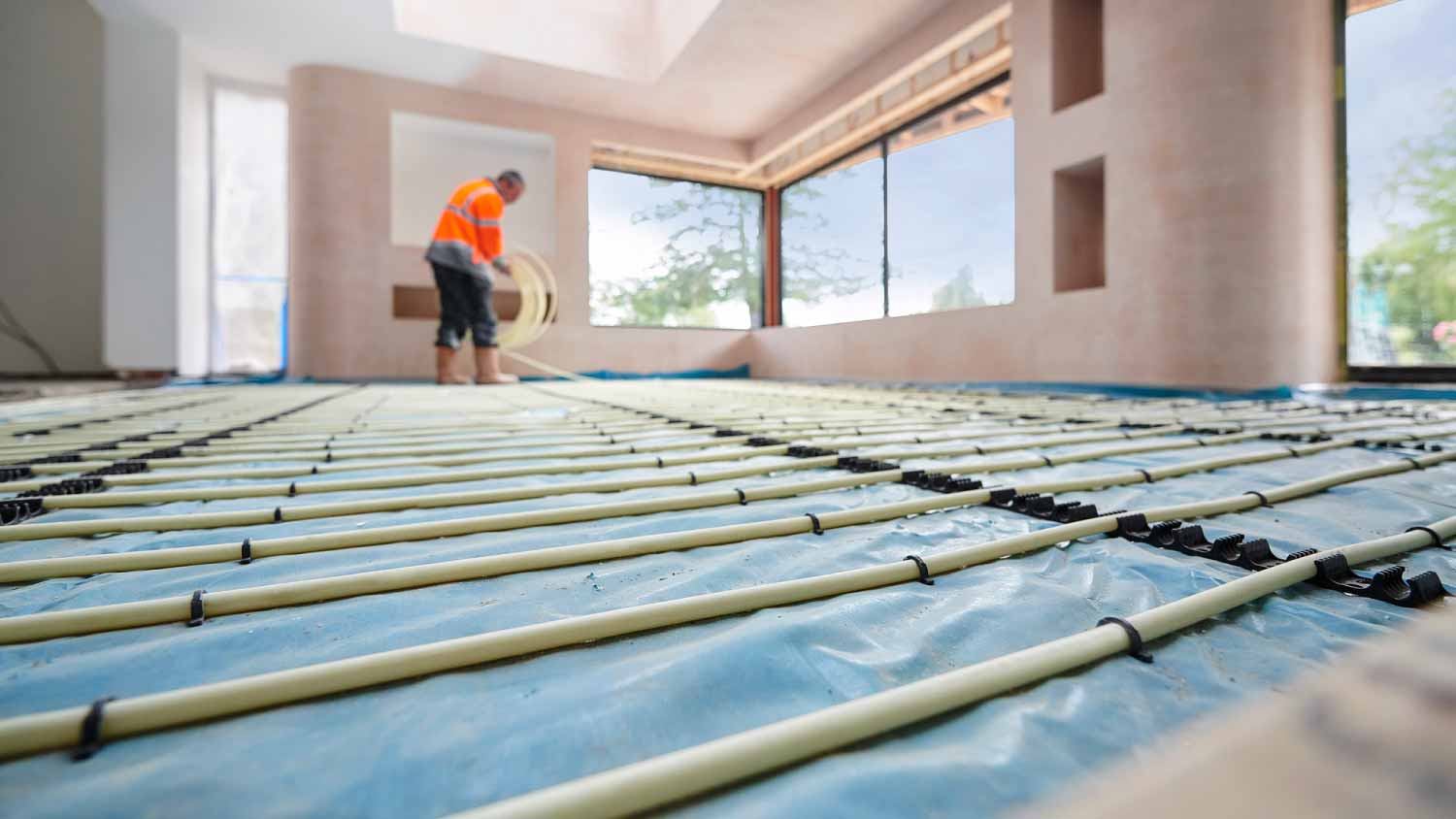
Gas furnace replacement costs depend on the type of furnace you want and installation fees. Our guide explains all the factors involved in a new furnace cost.
Dig into the details of this underground heating option


A geothermal heat pump draws heat from underground that can be used to heat a home.
A geothermal heat pump in floor heating has many advantages, including low cost of use, effectiveness in winter, easy maintenance, and access to potential rebates.
However, this type of system can be very expensive to install and repair.
Alternatives include boilers and traditional heat pumps.
When it comes to an energy-efficient heating system, nothing pairs quite as well as a geothermal heat pump and a hydronic underfloor heating system. But although a geothermal heat pump in floor heating is environmentally-friendly, there are pros and cons to consider. While geothermal heat is highly cost-effective, installation can be expensive, and the system may not heat as quickly as traditional HVAC options. Also, adding this type of heating system to an existing house could require a sizable remodel. Let’s look at the details.
A geothermal heat pump is installed underground and moves heat out of the ground. The ground is an excellent storer of heat, which can linger even when the air above is very cold; this allows geothermal heat pumps to work very efficiently.
The particular type of geothermal heat pump we’re discussing in this guide is a hydronic version, which means it uses underground pipes to heat water and then pump that water into the house, where it warms floors. It’s not very good at cooling, but can be very effective on cold days (and very comfortable for bare feet).
| Pros of a Geothermal Heat Pump for Floor Heating | Cons of a Geothermal Heat Pump for Floor Heating |
|---|---|
| Energy-efficient and works well in cold weather | High installation costs |
| Easy to maintain | Better for new construction than remodels |
| Many rebate options | Not suitable for cooling a house |
| Saves on space | Repairs are challenging |
Geothermal heat pumps and floor heating bring many advantages to a home. Here are some of the pros that have the most impact.
While above-ground heat pumps can sometimes struggle in very cold winters or require backup heat, geothermal heat pumps can access warmth underground more reliably, making them a better choice for the coldest states.
Heat pumps in general are very efficient, but geothermal heat pumps are some of the most low-cost heating options around once they get up and running. If you’re using primarily floor heating, you can expect your energy costs to drop noticeably.
Radiant heating doesn’t need to move air to work, which allows people with asthma or other health conditions to cut down on how many allergens move through their homes.
A geothermal heat pump is designed to last for many years and doesn’t require the same kind of maintenance that a boiler or similar system would.
Geothermal heating is extremely clean and green, which means there are usually tax rebates and other benefits associated with their installation. It doesn’t require natural gas or a nearby propane tank, so it can work in areas where these fuels aren’t readily available.
Most components of a geothermal heat pump are installed underground, so they don’t take up space the way a boiler would. This also makes their operation very quiet.

While geothermal heating for your floor may sound like a dream come true, there are a few issues that homeowners should consider before making a final decision. Here are some of the downsides to consider.
Geothermal heat pumps, especially large models, can cost multiple times more than what a standard heat pump, furnace, or boiler would cost. And if you’ve got rocky soil or similar difficulties, excavation costs can rise even higher. Be sure to contact several local geothermal companies for quotes.
It’s tough to install both geothermal heat pumps and floor heating on an old house. Extensive remodels are required. A geothermal heat pump in floor heating is much easier to put in when the house is still in the planning or construction phase.
Hydronic floor heating is excellent for slowly but surely warming rooms, especially in cold weather and with compatible hard flooring. However, it can’t really cool down a house in the same way. If you have hot summers, you’ll need an additional heat pump or air conditioner to cool down the air.
Since so much of a geothermal heat pump is underground, when it’s damaged (such as by encroaching tree roots or a settling foundation) the repairs are difficult to diagnose and expensive to address.

Sometimes a geothermal heat pump isn’t the right fit because of cost or excavation requirements. But that doesn’t mean you need to give up on floor heating entirely. If you’re determined to install underfloor heating in your house, you still have alternative heating options, including:
A boiler dedicated to hydronic radiant heating
Electric radiant heating with heating cables, suitable for smaller areas like bathrooms or garage floors
Radiant heating using standalone heating elements like electric baseboard heaters, which are close to the floor and don’t require remodeling
These options are generally less expensive to buy and install than a geothermal heat pump, but they don’t have the same efficiency over time, so be aware of the tradeoffs.
The first question many homeowners have about geothermal heating is if they need to live in a special kind of location or climate for it to work. Good news: Today’s geothermal heat pumps are so efficient that they can be installed nearly anywhere and provide excellent results (although rocky soil and bedrock can still pose challenges). You can also choose deeper or more shallow systems depending on what the ground around your home is like.
Other signs that a geothermal heat pump is right for you can include:
Tile or vinyl floors that can benefit the most from a radiant heating system
Cold winters where a standard heat pump won’t work as efficiently
A new home or a planned construction where installing a geothermal unit and floor heating is much easier compared to retrofitting
Lack of a reliable heating alternative like natural gas lines
Local utility companies that offer rebates, discounts, or even special loans for installing a geothermal unit
An interest in exploring environmentally-friendly heating options
From average costs to expert advice, get all the answers you need to get your job done.

Gas furnace replacement costs depend on the type of furnace you want and installation fees. Our guide explains all the factors involved in a new furnace cost.

Discover the true window AC unit installation cost to learn about labor, permits, and ways to save on your window AC project.

A blower door test can identify air leaks in your home and help boost energy efficiency. Use this blower door test cost guide to see what your test will total.

Your return air vent is responsible for removing warmer air, so testing it ensures you keep your environment comfortable and there are no HVAC problems.

Learn how to add Freon to your AC unit with our step-by-step guide, and keep your home cool with a properly functioning AC unit.

If you’re having issues with your heating and cooling system, it’s probably time to discuss these heat pump questions with your HVAC pro.